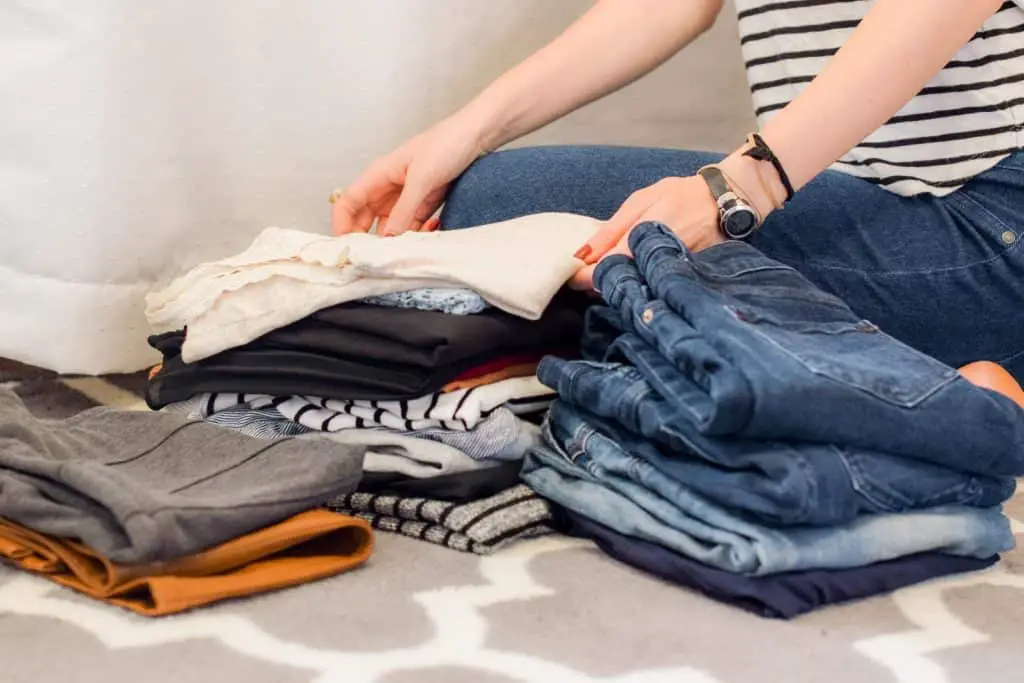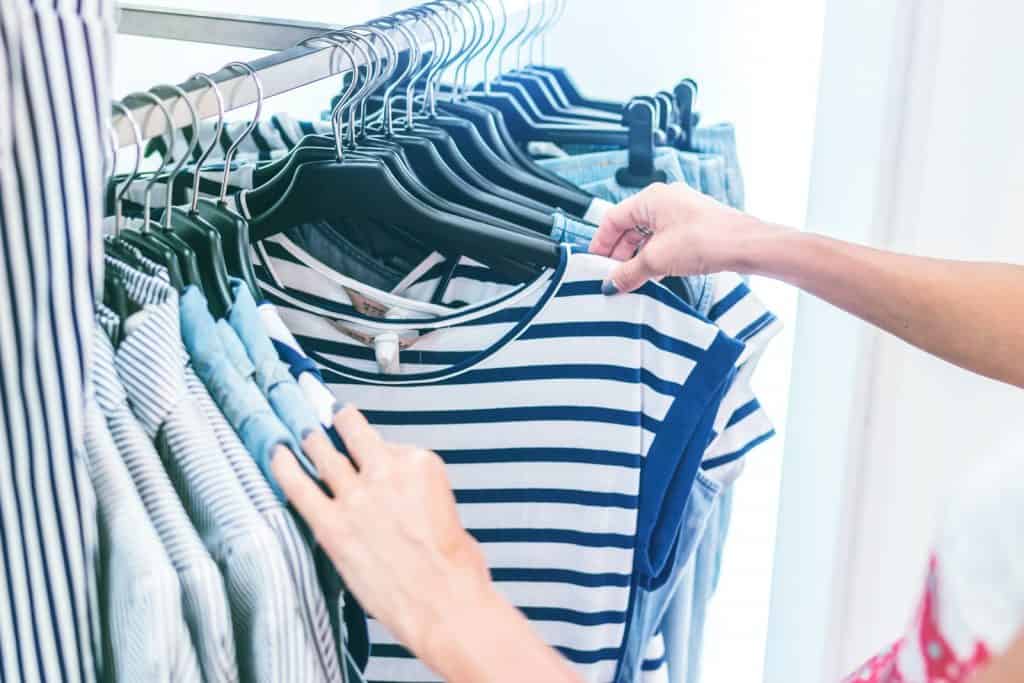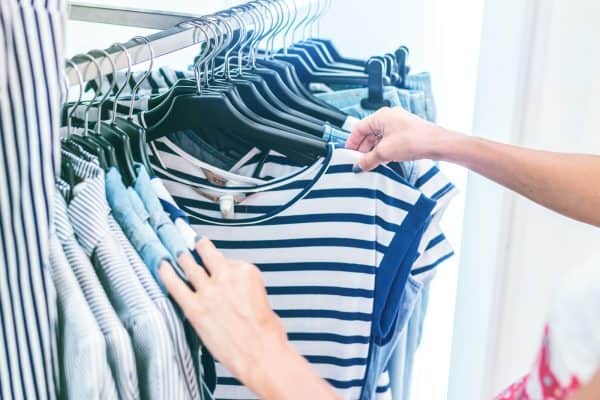How to create an affordable capsule wardrobe
Creating an affordable capsule wardrobe is an aim many people have, especially if they have overbought clothing in the past and would like to declutter and simplify their wardrobe.
Magazine articles and Pinterest graphics make it look so simple; a pair of jeans, a couple of T-shirts, a dress, a sweater and a few accessories – however in reality this simply does not take into account the needs of real people.
Are you seriously going to wear the same clothes for work as you do for leisure, for example? What are you going to wear when you’re chilling at home watching Netflix or cleaning the bathroom? Because I’ve never done either of these things looking like I’m dressed for brunch with friends and I’m pretty sure no one else has either.
If you’re looking to create an affordable capsule wardrobe that actually works, then hopefully you will find these tips useful.
What is a capsule wardrobe?
A capsule wardrobe is a collection of clothes and accessories which can be interchanged to keep a simpler wardrobe . It’s usually made up of classic pieces that will last for a while, with on-trend or seasonal pieces that can be added and amended as necessary.

How to create an affordable capsule wardrobe
Assess what you already own and declutter
You probably knew this step was coming, but nevertheless it is the most important in creating an affordable capsule wardrobe. Anything you already own is going to be a bonus because you already have it.
Take stock of everything you have and start putting them into piles. What items do you wear all the time? These are going to be your staple pieces. Start to categorise each pile according to where you wear it, as this is crucial to ensuring it will actually work for you.
At this point, don’t worry about getting rid of anything, just assess how much of each category you have.
Everyone’s lifestyle is unique, so make sure the categories fit your situation. They might include:
Everyday wear
Jeans, t-shirts, casual dresses that you wear for everyday life (but not for just sitting around the house – see below).
Workwear
If you have a work uniform or specialist clothing then obviously disregard this. But if you fund your own workwear for office or teaching jobs for example, then you probably need this category. Personally as a teacher, I don’t like wearing anything I wear in my leisure time for work.
I often “relegate” older clothes I’m tired of from my wardrobe to the workwear category which is a good way of utilising something you don’t want to get rid of but find you don’t wear as much any more.
Casual/Lounge Wear
Let’s be real here. This is something most capsule wardrobe systems fail to take into account but it is probably the category we need the most! If you work from home, are a stay at home mum or simply get in from work most nights and want to chill out, you probably need more than the one pair of comfy leggings most capsule wardrobe systems suggest.
Activewear
If you work out or have a hobby that requires specific clothing, put this into its own category.
Smart / Formalwear
This could range from what you wear for a meal out with friends to outfits you wear for weddings or formal occasions. If you prefer, you could split these two categories.
Seasonal
It’s entirely up to you if you want to make seasonalwear its own category, or if you just slot seasonal pieces into each of the categories above, such as daywear. If you have beachwear that only gets worn on holiday / vacation, or live in a place like here in the UK where summer clothing cannot be worn all year round, then you might wish to keep it separate and bring it out when needed.
Everything else – (Don’t forget your PJs!)
Underwear and sleepwear are not strictly part of your capsule wardrobe, but they still need taking into account.

Next step: The Purge
Hopefully you will now have several piles of clothing in each of your categories. This is where you can assess what to keep and what to get rid of.
For each pile, go through and assess:
What you wear regularly
These are obviously things to keep and will form the basis of your capsule wardrobe.
What pieces do you never wear?
And what is the reason behind each item? If it’s not your style any more, bought on a whim in the sale, too big / too small / damaged – then get rid.
How much of each item you have vs what you need
This is crucial and another key factor in determining a capsule wardrobe that will actually work for you. If you work out 4 times a week, then paring down to one activewear outfit is not going to be realistic.
Similarly, if you work 5 days a week in an office, you’re going to need items that can be mixed and matched to create at least five different outfits, plus seasonal variations for hotter or colder weather.
Good quality items can be sold on eBay or Vinted, or donated to charity. Anything damaged or stained can be recycled. Check if you have clothing and textile recycling points near you.
If there is something you love but never know when to wear it or what to wear with it, then keep it. This is where in the next step you can add new pieces to complement items like this.
For categories such as Formalwear and Seasonal where the items won’t get worn as much, apply the same principles. If you had a wedding or formal dinner next week, which outfits would you definitely wear and which would you definitely not? Keep those you love and purge the ones you know you won’t wear again.
Assess your past buying habits
Sorting your clothes into piles might have thrown up some buying habits you weren’t aware of. Do you have multiple similar items you keep buying?
Maybe you are in a comfort zone of buying what is familiar to you, or you are searching for the perfect striped t-shirt and keep buying variations on the same theme.
Acknowledge anything that has come up for you and make a note of what you definately don’t need any more of.
Start Building Mix and Match Outfits
For your main categories of daywear and workwear (if applicable), start building mix and match outfits from your existing streamlined piles. Start with what you already naturally wear (unless you really hate it and are ready for a change).
Everyone’s own style is different, but basics for daywear might include:
- Jeans
- Black leggings
- Plain tshirts
- A day dress (even better if it can be worn with or without leggings or tights)
- Jumpers and cardigans – if these are in plain, neutral shades such as black, grey and cream they will likely go with more pieces.
- Skirts – skirts are great as they can be mixed and matched with different tops.
- A fitted blazer – this can be good to smarten up an existing combination.
You probably won’t need to do this too strictly for your active, formal and loungewear categories, but just ensure you have enough options that go together, and get rid of anything ill fitting, beyond repair or that you no longer like.
Remember, if you workout 5 times a week then you’re likely going to need more than one pair of gym pants!
Similarly, if you realise you have 7 pairs of comfy loungewear pants, you may decide you don’t need this many.
Fill the clothing gaps
Once you have pared down your wardrobe, you may know exactly what is needed to fill the gaps. Equally, you might not have a clue where to start.
I really like Thread to get inspiration and ideas for style. You can sign up for free and go though a series of questions and images to assess your style, colouring and body type. You then get emails from a stylist suggesting pieces that would suit you. (This is a personal recommendation and not a sponsored link).
Of course, the point of their service is that you can buy via their recommendations, but obviously you’re not obliged to. It can be a great way of getting personalised styling tips for free with the added bonus of being able to buy something you love, as opposed to finding a random image on Pinterest and having to try and trawl the internet looking for something similar.
If you find you are missing basics such as plain tshirts, then this is a good place to start. Try to buy good quality brands so they last longer and look better.
Once you have everything on the basics list, you can start to add the more on-trend pieces to change up the look of the outfit. These don’t have to be as good quality if they are going to be swapped out reguarly. Again, everyone’s taste is different but this could include;
- Patterned scarves
- Logo / Slogan T-shirts
- A pop of an on-trend colour, e.g. in a bag, scarf or top
- A patterned dress

How to save money when buying clothes
Once you have identified what you now need to buy, obviously we don’t want to end up spending a load of money, as the whole point of this post is to create an affordable capsule wardrobe. Here’s some tips to save money when buying clothes.
Look out for sales
It’s an obvious one, but a good one. The danger can be just buying things you don’t need simply because it’s on sale. Having just purged your wardrobe of past sale faux-pas, hopefully this won’t be too hard to resist. You can also counter distractions by having a list of exactly what you need from your capsule wardrobe list, and ignoring everything else.
I specifically have money set aside for the Boxing day sales here in the UK, and a list of clothes I’m looking for. This has allowed me to buy from good quality brands such as Boden and Joules for up to 70% off full price.
Sign up for mailing lists
Lots of companies offer discounts for new customers on their first purchase when they sign up for the mailing list. Check the T&Cs though as this usually does not include sale items. You can always unsubscribe from their emails, but often as a subscriber you will be alerted to the sale dates, which can be handy.
Shop preloved
I have to admit, this is something I have only recently started doing, as a rummage through my local charity shops never really turned up many gems, and it is not something that appealed to me on eBay.
However, I absolutely love Vinted for buying preloved clothes! It is so easy to search the app via size and brand and I have found some amazing bargains on there from brands including Crew Clothing, Barbour and Joules.
Use Cashback
It’s always worth checking if you can get cashback on purchases you were making anyway. My favourite cashback sites is Airtime Rewards mainly because once you add your bank card, cashback will automatically be added.
Remembering to check cashback apps before I buy is not my strong point unless it is a large purchase, so it’s great to get cashback on small amounts automatically.
Topcashback also has a great range of fashion brands eligible for cashback when you click through via their app.
Shop at outlet stores – online and physical
Many people are aware of physical outlet malls such as Biscester Village and McCarther Glen, but did you know there are many online outlet stores?
Many top high street brands such as Joules, Boden and Quiksilver have an eBay outlet store. Even Amazon has a Fashion outlet section of its website.
Ask for Giftcards instead of a gift
This one might seem a little cheeky and will depend on your family situation, but if you have relatives who always buy you birthday and Christmas gifts and never know what to get you, consider asking for specific gift cards instead.
This way you can put them towards clothing you actually want, and even better if it’s Christmas and you can take advantage of the Boxing Day / January sales.
How to organise your capsule wardrobe
Once you have re-organised your wardrobe, ensuring everything is easily accessible is key. Not only will you save time in the mornings instead of rooting through drawers, you should save money too as the chances of over buying similar items will be reduced.
Hang things up carefully
The simple tip I picked up from The Home Edit of turning clothes the right side out when you go to hang them up really helps your wardrobe look more attractive. It only takes seconds to do and it’s a habit I’ve managed to stick with when putting laundry away.
Ensuring everything is hanging facing the same way on good quality hangers also works wonders. While I’d love to go out and buy all new matching hangers like this, instead I purged the worst hangers from my excessive collection and put everything on my existing better quality hangers.
Organise Your Drawers
Folding clothes Marie Kondo style is another habit I have managed to stick with ever since reading The Life Changing Magic of Tidying, but using drawer organisers like this is also helpful to compartmentalise small items like socks and underwear.
Store other items visibly
Over the door shoe organisers like this can be great for flat shoes, but can also be useful for small items like scarves, swimsuits and costume jewellery, especially if they are clear plastic.
For larger items such as bags, storing in clear plastic boxes like this helps you keep track of the contents.
Will these tips help you build an affordable capsule wardrobe?
Has this post helped you think of ways to create an affordable capsule wardrobe? Do you have any more ideas? Please leave a comment and share with the community.
Other Posts You May Like
Tips & Tricks to Maximise Rewards with the Boots Advantage Card
Get rewarded on your spending with Topcashback
How I bought £200 worth of goods for £6 cash in the Boxing Day sales










